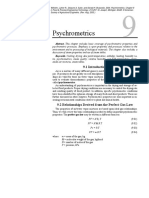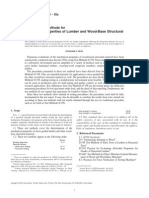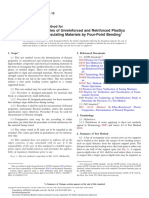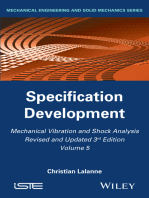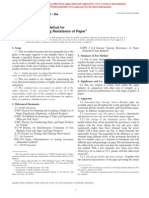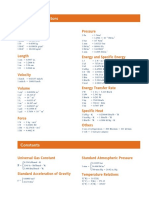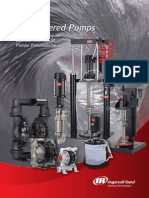0 ratings0% found this document useful (0 votes)
37 viewsVibration Testing of Shipping Containers: Standard Test Methods For
Vibration Testing of Shipping Containers: Standard Test Methods For
Uploaded by
Angel ValladaresThese methods cover vibration tests of filled shipping containers. They may be used to assess the performance of a container, with its interior packing and means of closure. These methods fulfill the requirements of International Organization for Standardization standards ISO 8318 and ISO 2247.
Copyright:
© All Rights Reserved
Available Formats
Download as PDF, TXT or read online from Scribd
Vibration Testing of Shipping Containers: Standard Test Methods For
Vibration Testing of Shipping Containers: Standard Test Methods For
Uploaded by
Angel Valladares0 ratings0% found this document useful (0 votes)
37 views5 pagesThese methods cover vibration tests of filled shipping containers. They may be used to assess the performance of a container, with its interior packing and means of closure. These methods fulfill the requirements of International Organization for Standardization standards ISO 8318 and ISO 2247.
Original Title
D 999 - 01 _RDK5OQ__
Copyright
© © All Rights Reserved
Available Formats
PDF, TXT or read online from Scribd
Share this document
Did you find this document useful?
Is this content inappropriate?
These methods cover vibration tests of filled shipping containers. They may be used to assess the performance of a container, with its interior packing and means of closure. These methods fulfill the requirements of International Organization for Standardization standards ISO 8318 and ISO 2247.
Copyright:
© All Rights Reserved
Available Formats
Download as PDF, TXT or read online from Scribd
Download as pdf or txt
0 ratings0% found this document useful (0 votes)
37 views5 pagesVibration Testing of Shipping Containers: Standard Test Methods For
Vibration Testing of Shipping Containers: Standard Test Methods For
Uploaded by
Angel ValladaresThese methods cover vibration tests of filled shipping containers. They may be used to assess the performance of a container, with its interior packing and means of closure. These methods fulfill the requirements of International Organization for Standardization standards ISO 8318 and ISO 2247.
Copyright:
© All Rights Reserved
Available Formats
Download as PDF, TXT or read online from Scribd
Download as pdf or txt
You are on page 1of 5
Designation: D 999 01
Standard Test Methods for
Vibration Testing of Shipping Containers
1
This standard is issued under the xed designation D 999; the number immediately following the designation indicates the year of
original adoption or, in the case of revision, the year of last revision. A number in parentheses indicates the year of last reapproval. A
superscript epsilon (e) indicates an editorial change since the last revision or reapproval.
1. Scope
1.1 These methods cover vibration tests of lled shipping
containers. Such tests may be used to assess the performance of
a container, with its interior packing and means of closure, both
in terms of its strength and of the protection it provides its
contents when it is subjected to vibration such as it experiences
in transportation. These procedures are suitable for testing
containers of any form, material, kind, design of interior
packing, means of closure, and any size and weight. They are
not intended for determining the response of products to
vibration for product design purposes, nor are they intended for
tests of products in their operational conguration as other
more suitable procedures are available for these purposes.
2,3
1.2 The following methods appear:
Method A1Repetitive Shock Test (Vertical Motion).
Method A2Repetitive Shock Test (Rotary Motion).
Method BSingle Container Resonance Test.
Method CPalletized Load, Unitized Load, or Vertical
Stack Resonance Test.
1.3 This standard does not purport to address all of the
safety concerns, if any, associated with its use. It is the
responsibility of the user of this standard to establish appro-
priate safety and health practices and determine the applica-
bility of regulatory limitations prior to use. Specic precau-
tionary statements are given in Section 6.
1.4 These methods fulll the requirements of International
Organization for Standardization standards ISO 8318 and ISO
2247. The ISO standards may not meet the requirements for
these methods.
2. Referenced Documents
2.1 ASTM Standards:
D 996 Teminology of Packaging and Distribution Environ-
ments
4
D 3580 Test Method for Vibration (Vertical Linear Motion)
Test of Products
4
D 4169 Practice for Performance Testing of Shipping Con-
tainers and Systems
4
D 4332 Practice for Conditioning Containers, Packages, or
Packaging Components for Testing
4
E 122 Practice for Choice of Sample Size to Estimate a
Measure of Quality for a Lot or Process
5
2.2 ISO Standards:
ISO 2247 PackagingComplete, lled transport
packagesVibration test at xed low frequency
6
ISO 8318 PackagingComplete, lled transport
packagesVibration tests using a variable frequency
6
3. Terminology
3.1 DenitionsFor denitions of terms used in these test
methods, see Terminology D 996.
3.1.1 double amplitude, nthe maximum value of a sinu-
soidal quantity (peak-to-peak).
3.1.2 octave, nthe interval between two frequencies hav-
ing a ratio of two (2).
3.1.3 power spectral density (PSD), nused to quantify the
intensity of random vibration in terms of mean-square accel-
eration per unit of frequency. The units are g
2
/Hz ((m/s
2
)
2
/Hz),
where g is the acceleration of gravity, equal to 386 in./s
2
(9.8
m/s
2
). Power spectral density is the limiting mean square value
in a given rectangular bandwidth divided by the bandwidth, as
the bandwidth approaches zero.
3.1.4 repetitive shock, nimpacts of a package on a test
platform which occur cyclically from input oscillatory motion.
3.1.5 resonance, nfor a system undergoing forced vibra-
tion, the frequency at which any change of the exciting
frequency, positive and negative, in the vicinity of the exciting
frequency causes a decrease in the response of the system.
4. Signicance and Use
4.1 Shipping containers are exposed to complex dynamic
stresses when subjected to vibration present in all transporta-
tion vehicles. Approximating the actual damage, or lack of
damage, experienced in shipping may require subjecting the
container(s) and contents to vibration inputs.
4.2 Resonant responses during shipment can be severe and
1
These methods are under the jurisdiction of ASTM Committee D10 on
Packaging and are the direct responsibility of Subcommittee D10.22 on Handling
and Transportation.
Current edition approved April 10, 2001. Published June 2001. Originally
published as D 999 48 T. Last previous edition D 999 96.
2
Military Standard Environmental Test Methods, MIL-STD-810F, Method 514,
Vibration, available from www.dodssp.daps.mil/dodssp.htm.
3
International Electrotechnical Commission Recommendation, Publication 68-
2-6, Part 2, Test F: Vibration, Basic Environmental Testing Procedures for
Electronic Components and Electrical Equipment, available from American Na-
tional Standards Institute, Inc., 11 W. 42nd St., 13th Floor, New York, NY 10036.
4
Annual Book of ASTM Standards, Vol 15.09.
5
Annual Book of ASTM Standards, Vol 14.02.
6
Available from American National Standards Institute, 11 W. 42nd St., 13th
Floor, New York, NY 10036.
1
Copyright ASTM, 100 Barr Harbor Drive, West Conshohocken, PA 19428-2959, United States.
may lead to package or product failure. Identication of critical
frequencies, and the nature of package stresses can aid in
minimizing the effect of these occurrences.
4.3 Vibration tests should be based on representative eld
data. When possible, the condence level may be improved by
comparing laboratory test results with actual eld shipment
data.
4.4 Exposure to vibration can affect the shipping container,
its interior packaging, means of closure, and contents. These
tests allow analysis of the interaction of these components.
Design modication to one or more of these components may
be utilized to achieve optimum performance in the shipping
environment.
4.5 Methods A1 and A2, Repetitive Shock Tests, are suitable
for tests of individual containers that are transported unre-
strained on the bed of a vehicle and may be suitable for tests of
containers that might be subjected to repetitive shocks due to
magnication of vibrations in unit loads or stacks.
NOTE 1Methods A1 and A2 produce different vibration motions, and
therefore, will generate different forces which may result in different
damage modes and intensities. Results from these two methods may not
correlate with one another.
4.6 Method B, Single Container Resonance Test, tests or
determines the ability of an individual container and its interior
packaging to protect the contents from transportation vibration,
particularly when the container and its contents might exhibit
resonant responses.
NOTE 2Individual products that are palletized might be better tested
using Method C.
4.7 Method C, Palletized Load, Unitized Load or Vertical
Stack Resonance Test, covers the determination of the presence
and the effects of resonance in palletized loads and multiple-
unit stacked loads, and whether or not the strength of the
containers is sufficient to withstand dynamic loads when
stacked.
4.8 Any or all of these test methods may be employed, as
determined by the appropriate performance specication, with
test intensities, frequency ranges, and test durations as called
for in the specication. Although these tests do not simulate the
shipping environment, they are intended to create the damage-
producing potential of the shipping environment. Results of
any one of these methods may differ from the results of the
others.
5. Apparatus
5.1 Method A1Repetitive Shock Test (Vertical Motion):
5.1.1 Vibration Test Machine, with a platform having a
horizontal surface of sufficient strength and rigidity so that the
applied vibrations are essentially uniform over the entire test
surface when loaded with the test specimen. The platform shall
be supported by a mechanism that vibrates it so the motion is
approximately a vertical sinusoidal input. (A rotary motion of
the platform is not acceptable.) The double amplitude displace-
ment of the vibration shall be xed at or controlled to 1 in. (25
mm), and the frequency shall be variable within the range from
2 to at least 5 Hz (cycles per second). The vibration test
machine shall be equipped with fences, barracades, or other
restraints to keep the test specimen from falling off the
platform without restricting its vertical motion.
5.2 Method A2Repetitive Shock Test (Rotary Motion):
5.2.1 Vibration Test Machine, with a platform having a
horizontal surface of sufficient strength and rigidity so that the
applied vibrations are essentially uniform over the entire test
surface when loaded with the test specimen. The platform shall
be supported by a mechanism that vibrates it so that the motion
is a rotational input with the vertical component approximately
sinusoidal. The double amplitude displacement of the vibration
shall be xed at 1 in. (25 mm), and frequency shall be variable
from 2 to at least 5 Hz (cycles per second). The vibration test
machine shall be equipped with fences, barricades, or other
restraints to keep the test specimen from falling off the
platform without restricting its vertical motion.
5.3 Methods B and CResonance Tests:
5.3.1 Vibration Test Machine, with a platform having a
horizontal surface of sufficient strength and rigidity so that the
applied vibrations are essentially uniform over the entire test
surface when loaded with the test specimen. The platform shall
be supported by a mechanism capable of producing vibration in
the vertical linear plane at controlled accelerations or displace-
ments, or both, over a controlled continuously variable range of
frequencies. (A rotary motion of the platform is not accept-
able.) Suitable xtures and attachment points shall be provided
to rigidly attach the test container to the platform for Method
B. Restraints shall be provided to restrain the horizontal motion
of the test specimens on the platform without restricting the
vertical motion of the specimen(s), for Method C.
5.4 InstrumentationAccelerometers, signal conditioners,
and data display or storage devices are required to measure and
control the accelerations at the test surface in Methods B and
C. Instrumentation may also be desirable for monitoring the
response of the containers and packaged items. The instrumen-
tation system shall have a response accurate to within 65 %
over the range specied for the test. Accelerometers should be
small and light weight enough as to not inuence the response
of the item being measured nor inuence the results of the test.
Detailed information on suitable instrumentation may be found
in the Shock and Vibration Handbook.
7
5.5 Conditioning ApparatusAdequate facilities shall be
provided for conditioning test specimens at selected humidity
and temperature prior to or during the test, or both, in
accordance with the requirements of the applicable specica-
tion.
6. Safety Precautions
6.1 These test methods may produce severe mechanical
responses of the test specimens. Therefore, fences, barricades,
and other restraints must have sufficient strength and must be
adequately secured. Operating personnel must remain alert to
potential hazards and take necessary precautions for their
safety. Stop the test immediately if a dangerous condition
should develop.
7. Test Specimens
7.1 The test specimen shall consist of the container, as
7
Harris, C. M., Shock and Vibration Handbook, McGraw-Hill, New York, NY,
1988, Chapter 16.
D 999
2
intended for shipment, loaded with the interior packaging and
the actual contents for which it was designed. Blemished or
rejected products may be used, if the defect is recorded prior to
the test. Dummy test items should be used for developmental
testing when necessary, but may not be used for nal accep-
tance testing.
NOTE 3Surrogate material may be used when actual product is
unacceptable for use (for example, package testing for hazardous materi-
als).
7.2 Sensors and transducers may be applied with the mini-
mum possible alteration of the test specimen, to obtain data on
the container or packaged item. When it is necessary to observe
the contents during the test, holes may be cut in noncritical
areas of the container.
7.3 Whenever sufficient containers and contents are avail-
able, it is highly desirable that ve or more replicate tests be
conducted to improve the statistical reliability of the data
obtained (see Practice E 122).
8. Conditioning
8.1 Condition test specimens prior to the test or during the
test, or both, in accordance with the requirements of the
applicable specication. When no conditioning requirements
are given, and the container materials are climatically sensitive,
a conditioning atmosphere is recommended (see Practice
D 4332 for standard and special conditions).
9. Procedure
9.1 Methods A1 and A2Repetitive Shock Tests:
9.1.1 Place the test specimen on the test machine platform in
its normal shipping orientation. Attach restraining devices to
the platform to prevent the specimen from moving horizontally
off the platform and to prevent excessive rocking, without
restricting the vertical movement. Adjust the restraining de-
vices to permit free movement of the test specimen of
approximately 10 mm (0.4 in.) in any horizontal direction from
its center position.
9.1.2 Start the vibration of the platform at a frequency of
about 2 Hz, and steadily increase the frequency until some
portion of the test specimen repeatedly leaves the test surface.
To ensure that the test specimen receives a continuing series of
repetitive shocks, a shim with a 1.6 mm (
1
16-in.) thickness and
a width of 50 mm (2.0 in.) shall be used to determine when the
test specimen is leaving the test platform by inserting it under
the package, a minimum of 100 mm (4.0 in.), and moving it
intermittently along one entire length of the package. Use a
shim of sufficient length to ensure operator safety, taking care
to keep the shim at on the vibration platform.
9.1.3 Continue the test at this frequency for a length of time
stated in the applicable specication, if any, or for a predeter-
mined period, or until a predetermined amount of damage may
be detected. The test may be stopped momentarily to inspect
for damage.
9.1.4 If the container might possibly be transported in any
other orientations, test at least one container in each possible
orientation for the full specied test duration.
NOTE 4When no test duration is specied, a test duration of 1 h is
recommended. Practice D 4169 may also be referred to for test durations.
9.1.5 Inspect the container and its contents and record any
damage or deterioration resulting from the test.
9.2 Method BSingle Container Resonance Test:
9.2.1 Fasten the test specimen, in its normal shipping
orientation, securely to the platform of the vibration equipment
so that the specied vibration condition is transmitted to the
outer part of the container. Mount the accelerometer to either
the top or bottom of the platform, as close to the test item as
possible, (insuring the accelerometer is not damaged by the
product) or in a location that produces data representative of
table motion. Monitor the amplitude and frequency data
achieved on the platform to ensure that the desired test
conditions are produced.
9.2.2 Determine resonance frequency or frequencies in one
of two ways: sine sweep or random input.
9.2.2.1 Resonance Search Using Sine SweepAdjust the
vibration test apparatus to produce the specied constant
acceleration amplitude (zero-to-peak) over the specied range
of frequencies. Starting at the lowest frequency, sweep the
frequency of the vibration at a continuous logarithmic rate of
0.5 to 1.0 octaves per minute to the upper frequency limit and
back to the lower limit. Repeat this complete cycle twice,
recording all the resonant responses of the test specimen. These
resonance frequencies can be determined in a variety of ways,
including auditory (listening to the response), visual (a strobo-
scope or video system may be benecial aids), or with an
accelerometer.
NOTE 5Resonance frequency or frequencies may differ between
sweep up and sweep down. The natural frequency of the test specimen is
approximately midway between the apparent resonance frequency (ies)
found on the sweep up versus the sweep down.
NOTE 6If no test severity is specied, an acceleration amplitude of
0.25 gs 0.5 g (2.45 m/s
2
4.9 m/s
2
) (zero to peak) over the frequency
range from 3 to 100 Hz is often sufficient to excite resonance. Practice
D 4169 also may be referred to for test level and duration recommenda-
tions.
9.2.2.2 Resonance Search Using Random Vibration
InputAs an alternative to using sine sweep for identifying
resonance frequency or frequencies of a packaged product, it
may be faster to use random vibration input, where a wide
frequency input band excites all of the natural frequencies of a
packaged product simultaneously. Please see Test Method
D 3580 for further discussion of using random vibration input.
To utilize this methodology, it is necessary to attach an
accelerometer, or accelerometers, to the product to monitor
maximum response frequencies. It is also necessary to attach
an accelerometer to the platform to assure the platform motion
is representative of the desired PSD input spectrum. Mount a
transducer in such a way as to identify the resonant frequency
or frequencies of the package in the direction of the table
motion.
9.2.2.3 The minimum frequency range should be from 3 to
100 Hz at a minimum power spectral density (PSD) level of
0.005 g
2
/Hz (0.049 (m/s
2
)
2
/Hz), or a spectrum known to be
appropriate. Note that this spectra does not represent any
particular real world environment but simply allows one to
identify package natural frequencies within the area of forcing
frequencies found most often in transportation. Start the
vibration system such that the PSD levels do not overshoot the
D 999
3
desired spectrum during startup. Initiate the test at least 6dB
below full level and increment in one or more subsequent steps
to full test level. Allow the control system to stabilize suffi-
ciently to represent a stable spectrum shape and level. Compare
the input with the response. Record the resonance responses of
the test item.
NOTE 7It should be noted that some existing vibration test equipment
has limited frequency range capability and additional equipment may be
needed to cover the entire recommended frequency range.
9.2.3 Dwell for the specied length of time at each resonant
frequency determined in 9.2.2.1 (limited to a maximum of the
four most severe resonances), or until damage to the container
is noted, whichever occurs rst. Adjust the frequency of
vibration as necessary to maintain resonance.
NOTE 8If no dwell time is specied, a dwell of 15 min is recom-
mended. Practice D 4169 may also be referred to for test durations.
9.2.4 Repeat the procedures of 9.2.1, 9.2.2.1, and 9.2.3 with
the container oriented in those orientations that might be
expected to occur in distribution.
9.2.5 Inspect the container and its contents and record any
damage or deterioration resulting from the test.
9.3 Method CPalletized Load, Unitized Load, or Vertical
Stack Resonance Test:
9.3.1 Place the full-size unitized or palletized load(s) of test
specimen(s) on the test machine platform to a height equal to
that used in the mode of shipment. It is best to test the load
exactly the way it is prepared for normal shipment, that is,
stretch wrap, banding, stacking conguration, etc. A single
vertical column of containers may be used if vertical stacking
alignment is used in shipping. Attach restraining devices to the
platform to prevent the specimen(s) from horizontal movement
off the platform, and to prevent toppling and excessive rocking.
Adjust the restraining devices to permit free movement of the
test specimen(s) of approximately 10 mm (0.4 in.) in any
horizontal direction. Attach the accelerometer to the platform
as close as possible to the test specimen(s), but protected so
that it will not be contacted.
9.3.2 Determine resonance point(s) in one of two ways: sine
sweep or random input.
9.3.2.1 Resonance Search Using Sine SweepAdjust the
vibration test apparatus to produce the specied constant
acceleration amplitude (zero-to-peak) over the specied range
of frequencies. Starting at the lowest frequency, sweep the
frequency of vibration at a continuous logarithmic rate of 0.5 to
1.0 octaves/min to the upper frequency limit, and then back to
the lower limit. Repeat this complete cycle twice, and record
all the resonance responses of the test load. These resonance
frequencies can be determined in a variety of ways, including
auditory (listening to the response), visual (a stroboscope or
video system may be benecial aids), or with an accelerometer
located on an upper package in the stack.
NOTE 9Multiple-unit loads likely are to exhibit several resonant
responses.
NOTE 10Resonance frequencies may differ between sweep up and
sweep down. The natural frequency of the test specimen is approximately
midway between the apparent resonance frequency found on the sweep up
versus the sweep down.
NOTE 11If no test severity is specied, an acceleration amplitude of
0.25 g (2.5 m/s
2
) (zero to peak) over the frequency range from 2 to 100 Hz
is recommended. Practice D 4169 also may be referred to for test level
recommendations.
9.3.2.2 Resonance Search Using Random Vibration
InputAs an alternative to using sine sweep for identifying
resonance frequency or frequencies of a unitized, palletized, or
stacked load, it may be faster to use random vibration input,
where a wide frequency input band excites all of the natural
frequencies of the test specimen simultaneously. Please see
Test Method D 3580 for further discussion of using random
vibration input. To utilize this methodology, it is necessary to
attach an accelerometer or accelerometers to an upper package
in the stack to monitor the maximum response frequency or
frequencies. This tansducer should be mounted on the outside
of the specimen to capture the resonance frequency of the load
versus the resonance information of the interior of the indi-
vidual package. It is necessary to attach an accelerometer to the
platform to assure the platform motion is representative of the
desired PSD input spectrum.
9.3.2.3 The minimum frequency range should be from 3 to
100 Hz at a minimum power spectral density (PSD) level of
0.005 g
2
/Hz (0.049 (m/s
2
)
2
/Hz), or a spectrum known to be
appropriate. Note that this spectra does not represent any
particular real world environment but simply allows one to
identify stack natural frequencies within the area of forcing
frequencies found most often in transportation. Start the
vibration system such that the PSD levels do not overshoot the
desired spectrum during startup. Initiate the test at least 6dB
below full level and increment in one or more subsequent steps
to full test level. Allow the control system to stabilize suffi-
ciently to represent a stable spectrum shape and level. Com-
paring the input with the response, record the resonance
responses of the test load.
9.3.3 Dwell for the specied length of time at each resonant
frequency determined in 9.3.2 (limited to a maximum of the
four most severe resonances), or until damage is noted in the
load, whichever occurs rst. Adjust the frequency of the
vibration as necessary to maintain resonance.
NOTE 12If no dwell time is specied, a dwell time of 15 min is
recommended. Practice D 4169 may be referred to for test durations.
9.3.4 Inspect the container(s) and contents and record any
damage or deterioration resulting from the test.
10. Report
10.1 The report shall include the following:
10.1.1 Identication and description of the test specimens,
including the container, the interior packaging, and the product
(give size, weight, and any other pertinent details).
10.1.2 If Method C is used for unitized loads, describe the
unitized load and the height of the stack, and the unitizing
method employed.
10.1.3 Purpose of the test and the applicable performance
specication, if any.
10.1.4 Sequence of test methods and the test intensities,
frequencies, and durations used. State whether radom or swept
sine input was used to determine resonance frequencies. If
random, report the spectrum used.
10.1.5 Verication of compliance with the test method or
describe any deviations.
D 999
4
10.1.6 Number of replications of each test.
10.1.7 Atmospheric conditions the test specimens were
subjected to, both prior and during the test.
10.1.8 Any other test the specimens were subjected to prior
to this test.
10.1.9 Description of the apparatus and the instrumentation
used, including the date of last calibration.
10.1.10 Detailed descriptions and photographs of the xtur-
ing used in the test.
10.1.11 Results of the test.
10.1.12 Descriptions and photographs of any damage or
deterioration to the containers or their contents as a result of the
test(s).
10.1.13 State whether the damage created in the laboratory
testing replicates actual eld damage to the container and
contents.
10.1.14 All resonant responses and any observations that
may assist in correct interpretation of results or lead to
improvements in the design of the container, interior packag-
ing, or product.
10.1.15 Statement of whether or not the specimen(s) com-
plied with the requirements of the applicable specication.
11. Precision and Bias
11.1 Precision:
11.1.1 No information is presented about the damage-
producing ability of these methods, since the results are usually
nonquantitative.
11.1.2 Based on limited data from one laboratory, the
within-laboratory repeatability standard deviation for the pri-
mary resonance may be below 1 Hz, depending on the item
tested. Higher order resonances may have more variability.
11.2 BiasThe procedures in these methods have no bias
because there is no accepted reference material or procedure.
12. Keywords
12.1 repetitive shock; resonance; shipping container; stack
resonance; vibration
The American Society for Testing and Materials takes no position respecting the validity of any patent rights asserted in connection
with any item mentioned in this standard. Users of this standard are expressly advised that determination of the validity of any such
patent rights, and the risk of infringement of such rights, are entirely their own responsibility.
This standard is subject to revision at any time by the responsible technical committee and must be reviewed every ve years and
if not revised, either reapproved or withdrawn. Your comments are invited either for revision of this standard or for additional standards
and should be addressed to ASTM Headquarters. Your comments will receive careful consideration at a meeting of the responsible
technical committee, which you may attend. If you feel that your comments have not received a fair hearing you should make your
views known to the ASTM Committee on Standards, at the address shown below.
This standard is copyrighted by ASTM, 100 Barr Harbor Drive, PO Box C700, West Conshohocken, PA19428-2959, United States.
Individual reprints (single or multiple copies) of this standard may be obtained by contacting ASTM at the above address or at
610-832-9585 (phone), 610-832-9555 (fax), or service@astm.org (e-mail); or through the ASTM website (www.astm.org).
D 999
5
You might also like
- Astm D6272Document10 pagesAstm D6272beni firiyaNo ratings yet
- DMT Extraction Solvent Efficacy PaperDocument6 pagesDMT Extraction Solvent Efficacy PaperIgor SilvaNo ratings yet
- 2007 Civic Hybrid SystemDocument188 pages2007 Civic Hybrid SystemAngel Valladares75% (4)
- ASTM D1143 - Piles Under Static Compressive Axial Load PDFDocument11 pagesASTM D1143 - Piles Under Static Compressive Axial Load PDFdr91% (11)
- E529-04 (2011) Standard Guide For Conducting Flexural Tests On Beams and Girders For Building ConstructionDocument3 pagesE529-04 (2011) Standard Guide For Conducting Flexural Tests On Beams and Girders For Building ConstructionMuhammad SalmanNo ratings yet
- 15 5 15 Liquid NPK Dripping and Foliar Fertilizers Formulations and Production ProcessesDocument8 pages15 5 15 Liquid NPK Dripping and Foliar Fertilizers Formulations and Production ProcessesSergeEzhov100% (1)
- ASTM D 999 01 Vibration Testing of Shipping Containers PDFDocument5 pagesASTM D 999 01 Vibration Testing of Shipping Containers PDFManuel Castillo FernandezNo ratings yet
- D 880 - 92 R02 Rdg4ma - PDFDocument4 pagesD 880 - 92 R02 Rdg4ma - PDFomar alvaradoNo ratings yet
- Astm D6344-98 PDFDocument4 pagesAstm D6344-98 PDFRajeshNo ratings yet
- D790 - 10 PDFDocument11 pagesD790 - 10 PDFShanaka Jayasekara67% (3)
- 2007 Honda Civic Hybrid - General InformationDocument12 pages2007 Honda Civic Hybrid - General InformationAngel ValladaresNo ratings yet
- Psychrometrics - Theory and ExamplesDocument45 pagesPsychrometrics - Theory and ExamplesGatot NugrohoNo ratings yet
- 5 4 Friction Lab Write-UpDocument9 pages5 4 Friction Lab Write-Upapi-385003483No ratings yet
- Vibration Testing of Shipping Containers: Standard Test Methods ForDocument6 pagesVibration Testing of Shipping Containers: Standard Test Methods Foromar alvaradoNo ratings yet
- Astm D 999Document5 pagesAstm D 999sales1spreadNo ratings yet
- D4003 Kbmo1854Document5 pagesD4003 Kbmo1854MarcoNo ratings yet
- D 5331 - 03 - RduzmzeDocument2 pagesD 5331 - 03 - RduzmzeA MahmoodNo ratings yet
- Simulated Drop of Loaded Containers by Shock Machines: Standard Test Method ForDocument4 pagesSimulated Drop of Loaded Containers by Shock Machines: Standard Test Method ForMei Lee ChingNo ratings yet
- D 7030 - 04 RdcwmzaDocument4 pagesD 7030 - 04 Rdcwmzamario neriNo ratings yet
- D 3689 - 90 R95 - Static Tensile LoadDocument11 pagesD 3689 - 90 R95 - Static Tensile Loadanjas_tsNo ratings yet
- D4761Document10 pagesD4761Nadya ChandraNo ratings yet
- D 6537 - 00 - Rdy1mzcDocument7 pagesD 6537 - 00 - Rdy1mzcA MahmoodNo ratings yet
- D 1185 - 98a R03 RDEXODU - PDFDocument11 pagesD 1185 - 98a R03 RDEXODU - PDFomar alvaradoNo ratings yet
- Astm D6344 04Document2 pagesAstm D6344 04sales1spreadNo ratings yet
- Astm d4169Document12 pagesAstm d4169wdavid81100% (2)
- Deflections With A Falling-Weight-Type Impulse Load Device: Standard Test Method ForDocument4 pagesDeflections With A Falling-Weight-Type Impulse Load Device: Standard Test Method ForKOFFI YVANE KOUASSINo ratings yet
- D2714-03. Test Method For Falex Block-on-Ring CalibrationDocument4 pagesD2714-03. Test Method For Falex Block-on-Ring CalibrationNavneet YadavNo ratings yet
- ASTM D1185 98aDocument6 pagesASTM D1185 98anatoymahal188No ratings yet
- ASTM D3689-90 (1995) Stand Pile TestDocument11 pagesASTM D3689-90 (1995) Stand Pile TestSoonHan WaiNo ratings yet
- 62.4 Astm-D5731-95Document3 pages62.4 Astm-D5731-95meongoc5687No ratings yet
- ISTA 1E-14(17)Document10 pagesISTA 1E-14(17)cheng piaoNo ratings yet
- ASTM D-6653 - Altitude - TestDocument4 pagesASTM D-6653 - Altitude - TestMauricio Oliveira CostaNo ratings yet
- Mechanical Handling of Unitized Loads and Large Shipping Cases and CratesDocument5 pagesMechanical Handling of Unitized Loads and Large Shipping Cases and CratesCheong Fung TingNo ratings yet
- D4123 Resilient ModulusDocument4 pagesD4123 Resilient ModulusNurul RizalNo ratings yet
- Mechanical Handling of Unitized Loads and Large Shipping Cases and CratesDocument5 pagesMechanical Handling of Unitized Loads and Large Shipping Cases and CratesGabriel Herrera Gonzalez100% (1)
- D 4169 - 04Document12 pagesD 4169 - 04Tedy Rose SalutinNo ratings yet
- Astm D2290-08Document6 pagesAstm D2290-08285151No ratings yet
- Andard Guide ForDocument4 pagesAndard Guide FordevitulasiNo ratings yet
- Measuring Deflections Using A Portable Impulse Plate Load Test DeviceDocument5 pagesMeasuring Deflections Using A Portable Impulse Plate Load Test Devicemickyfelix100% (1)
- Deflections With A Falling-Weight-Type Impulse Load Device: Standard Test Method ForDocument3 pagesDeflections With A Falling-Weight-Type Impulse Load Device: Standard Test Method ForRaviteja ChanamoluNo ratings yet
- Astm D6653 D6653M 13Document2 pagesAstm D6653 D6653M 13Sutthavee KrairirkshNo ratings yet
- Flexural Properties of Unreinforced and Reinforced Plastics and Electrical Insulating Materials by Four-Point BendingDocument9 pagesFlexural Properties of Unreinforced and Reinforced Plastics and Electrical Insulating Materials by Four-Point BendingHernando ZambranoNo ratings yet
- Astm D903-98 (2017)Document1 pageAstm D903-98 (2017)Fatma IbrahimNo ratings yet
- D 3580 - 95 R99 Rdm1oda - PDFDocument4 pagesD 3580 - 95 R99 Rdm1oda - PDFHernan MartNo ratings yet
- F1140 PDFDocument5 pagesF1140 PDFรอคนบนฟ้า ส่งใครมาให้ สักคน100% (1)
- Astm D5112 22Document4 pagesAstm D5112 22surangkanapukwarnNo ratings yet
- d6066 (PotencialLicuefaccion)Document16 pagesd6066 (PotencialLicuefaccion)Victor HernandezNo ratings yet
- Astm D4577Document8 pagesAstm D4577Nicole KrauseNo ratings yet
- Static Tests of Wood Poles: Standard Test Methods ofDocument18 pagesStatic Tests of Wood Poles: Standard Test Methods ofAnonymous 6SHxUn1xd1No ratings yet
- D 4632 Â " 91 R96 RDQ2MZITOTFSOTYDocument4 pagesD 4632 Â " 91 R96 RDQ2MZITOTFSOTYRaphael CordovaNo ratings yet
- Astm D2290 00Document2 pagesAstm D2290 00MukeshNo ratings yet
- D 5094 - 04 - RduwotqDocument3 pagesD 5094 - 04 - RduwotqA MahmoodNo ratings yet
- Compression Resistance of A Container Under Constant Load: Standard Test Method ForDocument7 pagesCompression Resistance of A Container Under Constant Load: Standard Test Method ForGT-LUCAS BARCINo ratings yet
- Soil ModuliDocument15 pagesSoil Modulijoake spasNo ratings yet
- Astm D4541 2017 PDFDocument18 pagesAstm D4541 2017 PDFFernando Emmanuel BenitezNo ratings yet
- D 7369 - 11Document12 pagesD 7369 - 11LIYANA AHMAD SOFRI100% (2)
- ASTM D2435-11 (Inglés) PDFDocument15 pagesASTM D2435-11 (Inglés) PDFRodolfo Rojas MontenegroNo ratings yet
- Astm G14Document6 pagesAstm G14kashif ehsanNo ratings yet
- Measuring Deflections With A Light Weight Deflectometer (LWD)Document3 pagesMeasuring Deflections With A Light Weight Deflectometer (LWD)Juan Carlos MejiaNo ratings yet
- Astm C446Document2 pagesAstm C446Alexis DominguezNo ratings yet
- Methodologies for Seismic Safety Evaluation of Existing Nuclear InstallationsFrom EverandMethodologies for Seismic Safety Evaluation of Existing Nuclear InstallationsNo ratings yet
- Mechanical Vibration and Shock Analysis, Specification DevelopmentFrom EverandMechanical Vibration and Shock Analysis, Specification DevelopmentNo ratings yet
- Fatigue Assessment in Light Water Reactors for Long Term Operation: Good Practices and Lessons LearnedFrom EverandFatigue Assessment in Light Water Reactors for Long Term Operation: Good Practices and Lessons LearnedNo ratings yet
- Instruments, Measurement Principles and Communication Technologies for Downhole Drilling EnvironmentsFrom EverandInstruments, Measurement Principles and Communication Technologies for Downhole Drilling EnvironmentsNo ratings yet
- 2007 Civic Hybrid - SpecificationsDocument16 pages2007 Civic Hybrid - SpecificationsAngel ValladaresNo ratings yet
- 2007 Civic Hybrid About SafetyDocument3 pages2007 Civic Hybrid About SafetyAngel ValladaresNo ratings yet
- Internal Tearing Resistance of Paper: Standard Test Method ForDocument7 pagesInternal Tearing Resistance of Paper: Standard Test Method ForAngel ValladaresNo ratings yet
- Conversion Factors: Mass and Density PressureDocument4 pagesConversion Factors: Mass and Density PressureArmando MarquezNo ratings yet
- Herramientas Bombas PDFDocument172 pagesHerramientas Bombas PDFrgb0906No ratings yet
- STPM BIOLOGY SEMESTER 1 Chapter 1 CarbohydratesDocument9 pagesSTPM BIOLOGY SEMESTER 1 Chapter 1 CarbohydratesMabel Lee Shan Shan100% (4)
- F3160 16Document9 pagesF3160 16senthilNo ratings yet
- A GCE Chemistry 2814 01 June 2007 Question PaperDocument16 pagesA GCE Chemistry 2814 01 June 2007 Question Paperchelini2009No ratings yet
- Imagineer Day at Chico StateDocument3 pagesImagineer Day at Chico Stateapi-270436720No ratings yet
- Dimethyl SulfidesDocument9 pagesDimethyl SulfidesVohinh NgoNo ratings yet
- TS_USA_Investigation_Update_1728827433Document4 pagesTS_USA_Investigation_Update_1728827433Héctor J MontoyaNo ratings yet
- Monte Carlo Oil and Gas Reserve Estimation 080601Document24 pagesMonte Carlo Oil and Gas Reserve Estimation 080601Ahmed Elsharif75% (4)
- Volumetric Calculations: Munamba Pt. NC Pharm Calc 1Document8 pagesVolumetric Calculations: Munamba Pt. NC Pharm Calc 1Von Valentine MhuteNo ratings yet
- Chemistry 206 Advanced Organic Chemistry: Simmons-Smith Reaction: Enantioselective VariantsDocument0 pagesChemistry 206 Advanced Organic Chemistry: Simmons-Smith Reaction: Enantioselective VariantseraborNo ratings yet
- GOC-jeemain GuruDocument108 pagesGOC-jeemain GuruncomdpNo ratings yet
- PIP PCECV001 Guidelines For Application of Control ValvesDocument39 pagesPIP PCECV001 Guidelines For Application of Control ValvesAndresNo ratings yet
- Safety Data Sheet Hydraulic Sae 10WDocument6 pagesSafety Data Sheet Hydraulic Sae 10WAdam EsabaNo ratings yet
- Structurix Chemicals Brochure EnglishDocument7 pagesStructurix Chemicals Brochure EnglishadelNo ratings yet
- Lecture 5 - Radioactivity - 2 - Decay ChainsDocument30 pagesLecture 5 - Radioactivity - 2 - Decay ChainsAndres Felipe Limas MontañaNo ratings yet
- Shasun Company ProfileDocument16 pagesShasun Company ProfileElango25489No ratings yet
- Offshore Pipeline SystemDocument18 pagesOffshore Pipeline Systemjeedan100% (2)
- Mole CalculationDocument19 pagesMole CalculationWilliamNo ratings yet
- Geotechnical Properties of Kuwaiti "Gatch" and Their ImprovementDocument11 pagesGeotechnical Properties of Kuwaiti "Gatch" and Their Improvementhamef100% (1)
- Effects of An Oxygenated Additive On The Emulsification Characteristics of Two - and Three-Phase Diesel EmulsionsDocument9 pagesEffects of An Oxygenated Additive On The Emulsification Characteristics of Two - and Three-Phase Diesel EmulsionsAbdoel Wahied ArohmanNo ratings yet
- GD&T 4Document28 pagesGD&T 4unendratNo ratings yet
- Medical Gas Storage Guidelines and Requirements: October 2016Document14 pagesMedical Gas Storage Guidelines and Requirements: October 2016StefaniSisiliaHandoyoNo ratings yet
- Quantum DotsDocument8 pagesQuantum Dotshecaicedo77No ratings yet
- PB Modular Range Oil Gas enDocument98 pagesPB Modular Range Oil Gas enSai Phanindra Kumar MuddamNo ratings yet











